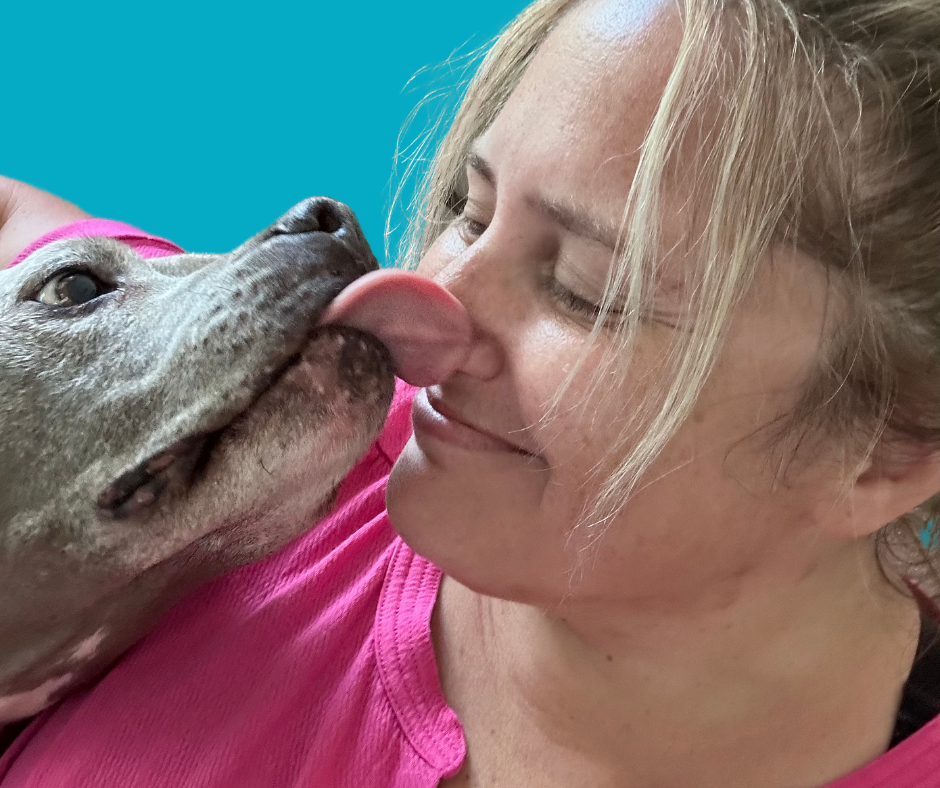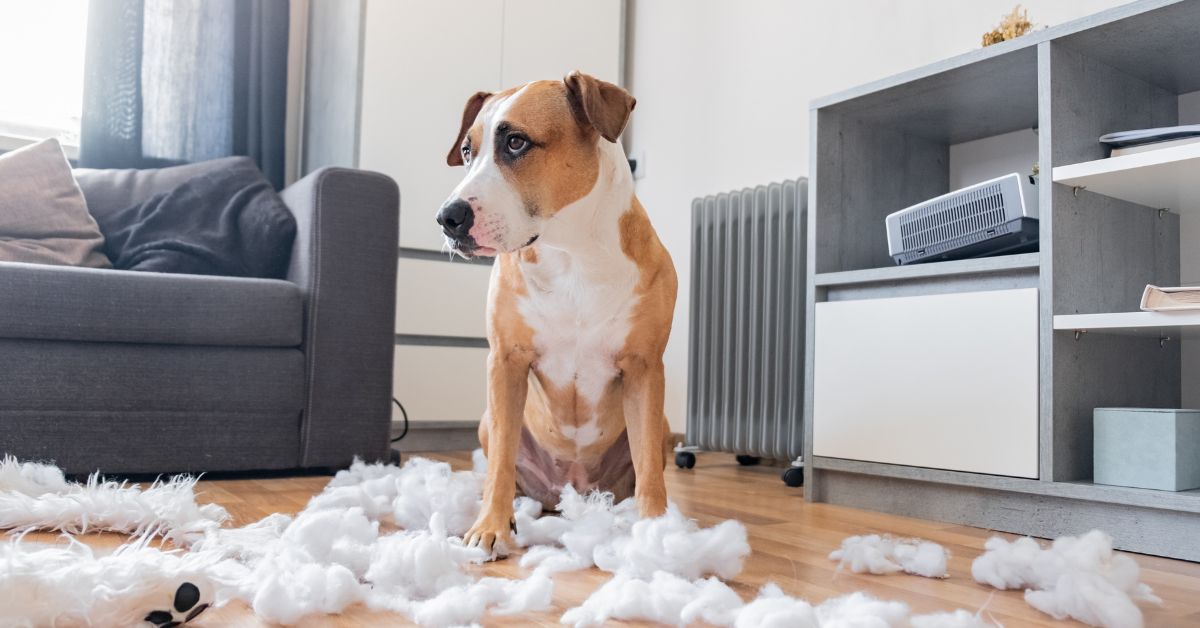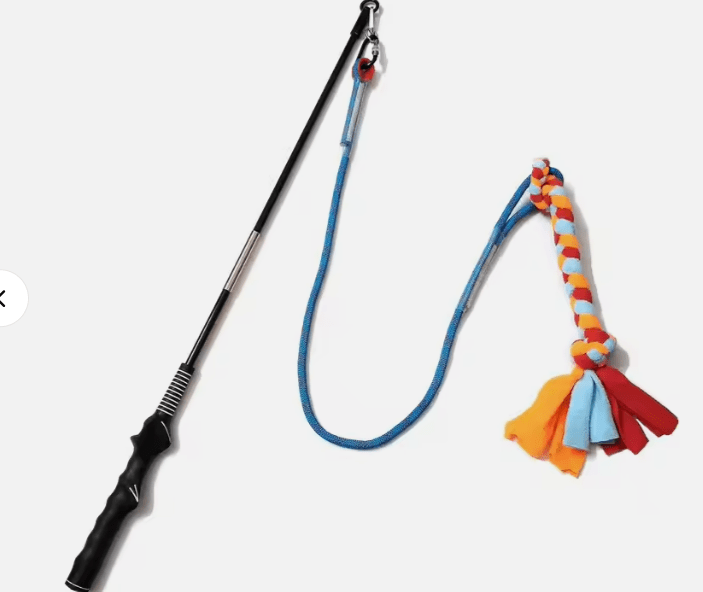As a dog guardian, it is important to provide your pup with engaging and stimulating activities to keep them physically and mentally healthy.
One of my favorite, and highly effective tools (that every dog guardian should look into) is a flirt pole. Have you ever heard of the flirt pole? The first time I was introduced one, many years ago when working with my reactive pup, I laughed.
I really thought it was just an oversized cat toy.
Now, this is not a toy that I just pulled out and started using... Can you imagine your dog pulling you all around because they don't want to give up their new favorite toy?
However with a little training, whether through training classes or something like a pre-recorded training that will be included in the next Canine Brain Games enrichment box.
What is Dog Emotional Regulation?
Are you asking yourself what is dog impulse control? Or do dogs have impulse control? These are great questions! Much like us, impulse control for dogs is the ability to control their actions or reactions to external stimuli.
And, much like us, impulse control needs to be taught. Think about how hard it can be for a child to not scream for the toy on the shelf. Your dog is not any different. Impulse control is otherwise known as emotional regulation.
Why Should I Teach My Dog Self-Control?
Impulse control dog training, or emotional self-control training, is a great way to help your dog tap into their natural drive and be able to come back down from the intensity to focus on you. With tools like the flirt pole, you can have fun with your dog while doing impulse training.
I mentioned how I responded to the flirt pole when I was first introduced, but not why I was being introduced to one.
My dog Freya was uncontrollable around anything with more than two legs. She was not socialized as a puppy, was badly abused and neglected, and was going to be sentenced to death by the local animal control after being confiscated from her abusers... Only because of her prey drive...
But this dog, she is the sweetest thing to any human, no matter how big or small.
Why is it fair to euthanize a dog who is simply tapping into their natural drive?

Impulse control games for dogs have become a big part of our lives because of her but for all the right reasons. Just like when I work with children who have physical outbursts in class, it's all about being able to regulate those REALLY BIG emotions.
This tool allowed Freya to tap into her VERY strong drive to hunt and chase. That allowed me to help work with her to teach her how to come back down from those big emotions. When she able to do that, a lot of things changed, like tearing you down the sidewalk to get the squirell.
Can you relate?

So, once you know your dog can become elevated in play, and then take a cue to self-regulate their emotions, break out the flirt pole!
Integrating the Flirt Pole Into Your Dog Enrichment Routine
To maximize the benefits of the flirt pole for dog enrichment, consider implementing these strategies:
-
Gradual Introduction: Begin with short, slow-paced sessions to acclimate your dog to the flirt pole. As they become more comfortable and skilled, gradually increase the intensity and duration of play sessions.
-
Cue Integration: Incorporate basic cues like "sit," "stay," or "leave it" during play. This reinforces impulse control by giving your dog the ability to follow instructions before engaging with the lure.
-
Energy Level Monitoring: Pay close attention to your dog's energy and excitement levels. If they become overly stimulated, take breaks to help them calm down before resuming play. This practice is crucial for developing their emotional regulation skills.
-
Safety Considerations: Always use the flirt pole in a safe area where your dog can run freely without risk of injury. Supervision is essential to prevent accidents and ensure a positive experience.
-
Reward Variation: Alternate between your dog catching the lure and then rewarding them for stopping on cue. This unpredictability keeps the game exciting and reinforces different aspects of impulse control.
Get Canine Brain Games To Teach Emotional Self Control
Our next enrichment box is all about emotional self-regulation and includes your very own FLIRT POLE! As well as a training, led by me, all about teaching your dog to "leave it" the fun way.

At Canine Brain Games, we're committed to strengthening the bond between you and your dog through engaging and educational brain games. Our subscription box service delivers carefully curated dog enrichment toys and activities designed to stimulate your dog's mind and improve their behavior.
Canine Flirt Pole Q&A
1. What is a flirt pole, and how does it work?
A flirt pole is essentially a long stick with a rope or cord attached, and at the end of the cord is a lure (often a soft toy). It's similar to a giant cat toy but designed for dogs. The idea is to move the lure quickly to engage your dog’s prey drive, encouraging them to chase, pounce, and exert energy while training their impulse control.
2. Why is the flirt pole beneficial for dogs with strong prey drives?
The flirt pole taps into a dog's natural hunting instincts, particularly in dogs with a strong prey drive like Freya. It allows them to chase and pounce in a controlled environment. This tool helps to channel that instinct into something positive, reducing problematic behaviors, while providing both physical exercise and mental stimulation.
3. How do you introduce the flirt pole to a dog for the first time?
Start with short, calm sessions. Allow your dog to observe the flirt pole and get used to its movement. Avoid overwhelming your dog with fast-paced motions initially. As your dog becomes more familiar with it, you can gradually increase the intensity and length of play sessions.
4. What are the benefits of teaching impulse control to dogs?
Impulse control allows dogs to manage their excitement and emotions, making them more responsive to cues from their guardians. It helps prevent undesirable behaviors like pulling on the leash, jumping on people, or chasing small animals, improving overall obedience and calmness in different situations.
5. Can all dogs benefit from flirt pole training, or is it only for certain breeds?
All dogs can benefit from flirt pole training! While it's particularly useful for dogs with strong prey drives, any dog can enjoy and learn from this type of play. The key is to tailor the intensity and duration to your dog’s energy levels and individual needs.
6. What is emotional regulation in dogs, and how does it relate to play?
Emotional regulation is your dog's ability to manage and control their emotional responses, like excitement or frustration. During play, especially with stimulating tools like the flirt pole, your dog can become highly aroused. Emotional regulation helps them "come back down" from that arousal and respond to cues like "sit" or "leave it," helping prevent over-excitement.
7. How can I incorporate flirt pole play into my dog’s enrichment routine?
Start by using the flirt pole a few times a week in short bursts of 5-10 minutes. Integrate basic training cues like “sit” or “stay” into the game to reinforce impulse control. Always monitor your dog’s energy levels and take breaks if they become overstimulated.
8. Why is it important to monitor a dog’s energy levels during flirt pole play?
Overstimulation can lead to frustration, injury, or a loss of impulse control. Monitoring your dog’s energy ensures that playtime remains positive and safe. If your dog gets too excited, taking a break allows them to calm down and regain focus.
9. What safety precautions should I take when using a flirt pole?
Always use the flirt pole in a safe, open area where your dog can run without obstacles. Ensure your dog is supervised at all times, and avoid excessive play that could cause joint strain, particularly in younger or older dogs. Also, make sure the flirt pole and lure are sturdy and suitable for your dog's size.
10. How does impulse control training improve my dog’s behavior outside of play?
When your dog learns to control impulses during play, they develop the ability to self-regulate in other situations. This can translate to better leash manners, reduced reactivity to stimuli like squirrels or other dogs, and an overall calmer demeanor when faced with exciting or stressful situations.
11. Why is impulse control important for reactive dogs like Freya?
Reactive dogs often struggle with overwhelming emotions and impulses, particularly when exposed to triggers like other animals or fast-moving objects. Impulse control training helps these dogs learn to manage those big emotions and respond calmly rather than reactively.
12. What is included in the Canine Brain Games Enrichment Box for impulse control training?
The upcoming enrichment box focuses on emotional self-regulation and includes a flirt pole as well as pre-recorded training on teaching the “leave it” command. This box provides tools and resources to help dog guardians work on impulse control with their dogs in a fun, engaging way.
13. How does Canine Brain Games support my dog's cognitive development?
By incorporating toys, activities, and training exercises that challenge your dog’s brain, Canine Brain Games helps improve problem-solving skills, impulse control, and emotional regulation. Each box is designed to stimulate both mind and body, promoting overall well-being and improved behavior.

